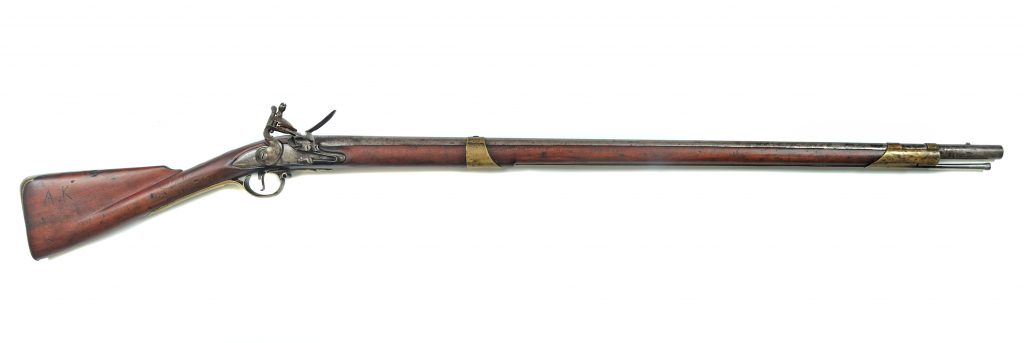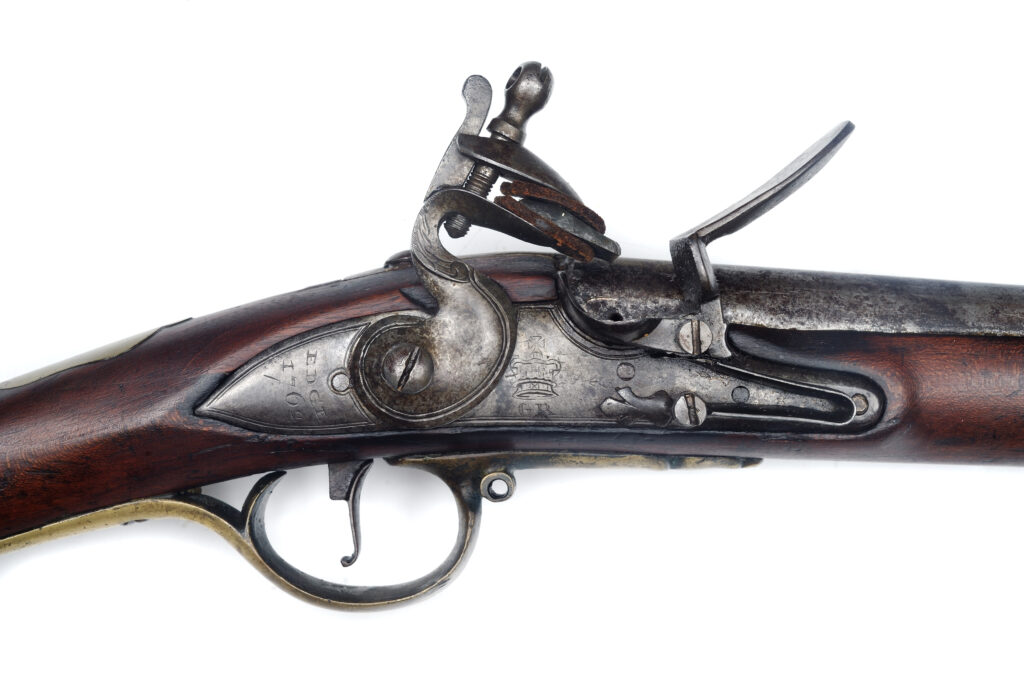
Captured aboard the transport ship Hope in May 1776, this British light dragoon carbine was issued to Continental Army troops for the New York campaign.
In May 1776, just two months after the British had evacuated Boston, a Massachusetts privateer captured an armed British transport ship, the Hope, near Boston Harbor. The enemy ship was filled with arms and equipment meant for the king’s troops, including one thousand carbines, several cannon and nearly fifteen hundred barrels of gunpowder. This windfall for the Continental Army—which, one year into the war, still struggled to supply its troops with enough suitable weapons—would test its leadership, as generals began fighting over the captured cargo while George Washington tried to assert his authority in the matter. The Institute’s collections include a British light dragoon carbine captured from the Hope, distinguished by the cherry stock and other alterations made by Continental armorers after these weapons arrived in America. This firearm—made in 1762 for British light dragoons, altered in 1775 for use by Crown forces in America, captured in 1776 by an American privateer, issued to Continental Army troops, and altered by American armorers for use against the British in the Revolutionary War—helps to tell broader stories of the tools and leadership required to win American independence.
In the summer of 1775, Col. Samuel Cleaveland, the senior British artillery officer in America and commander of the Fourth Battalion of Royal Artillery, wrote to London requesting that the Board of Ordnance, which was responsible for supplying the British military with arms and equipment, ship two thousand carbines to Boston. A light-weight smoothbore firearm, shorter than the standard infantry musket, the carbine was typically issued to British dragoon, light infantry and artillery troops. Colonel Cleaveland—and Gen. Thomas Gage, commander in chief of the British forces in America—intended the carbines for the sergeants in the battalion companies of all British infantry regiments in America, to replace the unwieldy halberts they were carrying. The Board of Ordnance agreed and sent the carbines aboard two storeships sailing with a fleet from Cork. Delays prevented their departure until early 1776, when the ships and their cargo finally made their way to Boston.
The carbines sent to Gage and Cleaveland were almost two decades old, part of the Pattern 1756 production of carbines issued to the light dragoon troops added to the British army that year. Trained to fight while on horseback, light dragoons specialized in scouting, patrolling and skirmishing. Shorter, lighter and smaller caliber than infantry muskets, the Pattern 1756 light dragoon carbines were also fully stocked to the muzzle, which made them incapable of taking a bayonet. During the early Seven Years War period, some of these carbines were altered to arm the Highland regiments before their deployment to North America. The forestock was cut back and fitted with a brass stud to mount a bayonet, the side bar for a horseman’s belt was removed, and sling swivels were added to allow soldiers to carry the weapons on leather slings. These alterations became codified in subsequent carbine patterns, but Ordnance storehouses did not contain enough of those more recent carbines when Colonel Cleaveland’s request arrived in 1775. Instead, armorers at the Tower of London pulled two thousand Pattern 1756 carbines still being stored and modified them as had been done for the Highland regiments.
The Ordnance transport ships began approaching the American coast in spring 1776, when one of them, the Hope, was separated from the convoy in a storm. She appeared off Nantasket Roads, a channel leading into Boston Harbor, on May 17, 1776, and was captured by an American privateer, the Franklin, commanded by Capt. James Mugford, Jr., of Marblehead. The Hope’s cargo included half of the carbines requested by Cleaveland, along with four cannon, almost fifteen hundred barrels of gunpowder, and additional tools and equipment. The same day the Hope was taken, Maj. Gen. Artemas Ward, commander of the Continental Army’s Eastern Department, wrote to George Washington reporting on this “very valuable Prize … laden with provisions and warlike stores for the Kings troops.” Before the commander in chief even received the news, Ward had divided the captured cargo for storage in Boston under the care of the assistant quartermaster general and the Continental deputy commissary of artillery in the city.

The lock bears the crown and George III cypher and a faint broad arrow proof mark, as well as the last name of its maker, Richard Edge, and the date 1762.
News of the capture of the Hope and her cargo quickly spread through the Continental Army’s leadership. Washington’s generals and other officers soon began lobbying to receive some of the prized arms, which remained limited among American troops. Col. Henry Knox wanted much of the cargo for his Continental Artillery. Col. Rufus Putnam, soon to be appointed chief of engineers at New York, requested engineering tools and equipment. Maj. Gen. Israel Putnam, who was stationed with Washington at headquarters in New York, sought similar tools for building fortifications—axes, shovels, hammers, spikes, and sandbags, among other supplies. And the “Gentlemen of the Town” of Boston, who had just formed an independent corps, asked that they be issued some of the carbines as they began recruiting.
Before responding to General Ward, Washington sought the support of Congress, which adopted a resolution that the commander in chief had authority over all the military stores captured by the Franklin—and any other cargo that would be taken by American privateers during the war. On May 28, 1776, eleven days after the Hope was captured, Washington wrote to Ward directing that most of the stores be sent immediately to New York, where the bulk of the main army was preparing to defend against an anticipated British attack. General Washington specifically ordered Ward to forward eight hundred of the carbines—complete with bayonets and cartridge boxes—and four hundred barrels of gunpowder to New York. He also authorized Ward to fulfill the requests made by Henry Knox and Rufus Putnam out of the rest of the cargo. The remaining two hundred carbines were to be stored in “some good & secure place not to be disposed of ‘till further directions.” Washington insisted that Ward not distribute these carbines to the recruits of the Independent Corps of Boston except “in case of Absolute necessity such as the Appearance of an Invasion or the like.” Washington specified that the remaining powder be “sent to some place of security in the Country not too contiguous to Boston there to be kept under a good & trusty guard, till It shall be disposed of, apprehending It imprudent that more shou’d remain in Boston than may be absolutely necessary for fear of Accidents”—contrary to Ward’s instinct to keep the powder in the city.
It would take months for the troops in New York to receive the carbines and other equipment. On June 3, Ward began sending some of the arms to Washington by way of Norwich, Connecticut. Capt. Israel Putnam, Jr., Major General Putnam’s son, supervised the transportation of these arms to New York. At the end of June, Washington ordered Ward to send the remaining two hundred carbines, “Being in the greatest distress here for Arms without the most distant prospect of obtaining a Supply.” Some of the carbines began arriving in New York in July and were issued in part to men serving under Brig. Gen. Thomas Mifflin at Fort Washington. As the summer wore on and the British threat to New York grew closer, an exasperated Washington repeatedly wrote to Artemas Ward noting the absence of the remaining carbines and urgently looking for news of their arrival. It would be until later in August that all one thousand carbines captured from the Hope three months earlier would be accounted for in New York.
The British light dragoon carbine in the Institute’s collections is one of the thousand captured from the Hope and sent to Continental troops in New York. Its lock bears the crown and “GR” cypher (the mark of royal ownership) and a faint broad arrow proof mark, as well as the last name of its maker, Richard Edge, and the date 1762. The .65-caliber, 37-inch-long barrel is one of the only other remnants from the carbine’s British origins. The barrels of the Pattern 1756 carbines were pin mounted in a slight way, and the weapons were susceptible to damage with heavy use. Soldiers turned in many of the captured carbines for repairs, which Continental armorers performed at workshops in Philadelphia, Lancaster and Springfield. To correct the guns’ flaws, the American armorers often restocked them and secured the barrel with French-style brass bands. The example in our collections was restocked during the Revolutionary War in American cherry wood and given new brass barrel bands and an iron ramrod, before being sent back into the field. Its survival provides tangible proof of how the Continental Army acquired, fought over, and fought with an important cache of British firearms.
View More Armaments